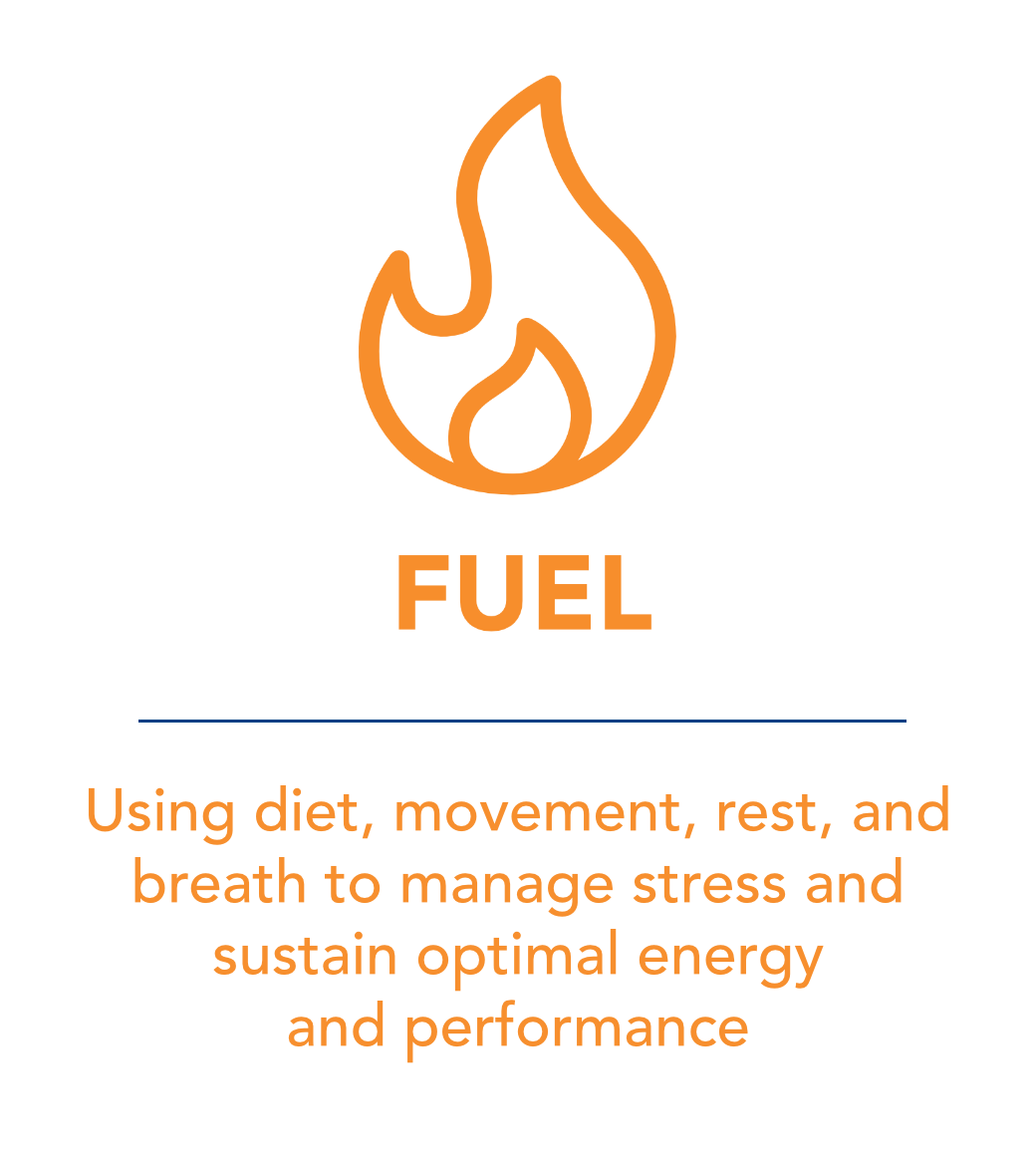 Cultures around the world have long known that eating well, getting plenty of physical activity throughout the day, enjoying high quality sleep, and breathing mindfully contribute to physiological and psychological vitality. Wise leaders have a personalized FUEL strategy that’s part of their daily routine, and they coach their teams to do the same.
Cultures around the world have long known that eating well, getting plenty of physical activity throughout the day, enjoying high quality sleep, and breathing mindfully contribute to physiological and psychological vitality. Wise leaders have a personalized FUEL strategy that’s part of their daily routine, and they coach their teams to do the same.
FUEL, one of the six key wellbeing dimensions measured in Be Well Lead Well Pulse®, is about the proactive and strategic use of diet, movement, breath, and rest for a sustained, balanced source of physical, emotional, and mental energy.
The FUEL dimension draws together four of the assessment’s 19 psychometrics of wellbeing leadership:
- Eating as Fuel: the extent to which you use your eating habits to positively manage stress, manage your energy, and perform at your best.
- Moving as Fuel: the extent to which you use physical activity to positively manage stress, manage your energy, and perform at your best.
- Resting as Fuel: the extent to which you use sleep and rest to positively manage stress, manage your energy, and perform at your best.
- Breathing as Fuel: the extent to which you use your breath to positively manage stress, manage your energy, and perform at your best.
Learning to use FUEL purposefully is one of the six essential shifts you can make to amplify thriving in your team and organization, starting with yourself.
Here are four innovative, zero-cost FUEL practices to test for yourself:
1. EATING FOR FUEL: Use your gut to regulate your emotions.
When Naomi, a beverage company executive I coached, complained of brain fog, anxiety, and reactiveness, we both knew these were signals of her experiencing too much stress. One of her strategies for boosting her cognitive and emotional wellbeing was to nurture a healthier gut microbiome. Why? Because recent evidence points to the gut microbiome as a key player in mental and physical health. Plus, gut microbiome diversity is linked to important personal leadership qualities, such as an openness and enjoyment of trying new things, emotional regulation, and higher levels of wisdom, compassion and social support. Eating a plant-forward diet, along with fermented foods (e.g., yogurt, kimchi, kombucha) and whole grains, are among vital strategies to build a thriving microbiome in your gut. Assess what you eat during a typical week. How can EATING FOR FUEL help you better regulate your emotions?
2. MOVING FOR FUEL. Lead an inclusive walk.
Apple’s former CEO Steve Jobs may have made walking meetings trendy years ago, but today they’re here to stay. Walking improves cognitive, physical, and emotional vigor and mood, boosts creativity by 81-100%, breaks down barriers of hierarchy, and builds openness and trust between people. A 2022 meta-study in The Lancet also reports that raising the step count from 3,000 to 7,000 per day reduces mortality risk by 50% for people over 50. Hold your next team meeting by strolling—that is, walking or rolling—together. Remember: An inclusive walking meeting isn’t about speed; allow the slowest person to set the pace. Enjoy time together to gain fresh perspectives from each other as well as your surroundings. If you’re working remotely, do an audio-only walking meeting. Or, take a personal, 10-minute awe walk to use MOVING FOR FUEL to restore yourself.
3. RESTING FOR FUEL. Enjoy non-sleep deep rest.
Google’s CEO Sundar Pichai swears by it. NSDR, such as yoga nidra or self-hypnosis, is a method of mental focus, done usually for 10-20 minutes, which you can incorporate into your day to relax, reduce reactivity and anxiety, ease pain, and gain clarity and calm. (I personally use a NSDR protocol in the early afternoon to reset my energy for the remainder of my day.) Because of its link to neuroplasticity, you can use NSDR immediately following a bout of learning as well to embody a new skill more rapidly. Dive into the science of NSDR in this interview with Stanford neurobiologist Andrew Huberman on the The Tim Ferriss Show, and experiment with this RESTING FOR FUEL practice (hit the play button below).
4. BREATHING FOR FUEL. Energize your leadership with breath.
You come into this world with an inhalation and leave it with an exhalation. In between these two incredible moments, breath is one of the most potent wellbeing leadership tools you have. Controlled breathing, often known as yogic breath or mindful breathing, can reduce chronic pain, lessen insomnia, and positively affect your immune system; plus, it helps you regulate your emotions, diminish impulsivity, counter gene expression changes that cause stress, and keep your brain sharp. BREATHING FOR FUEL is simply a gateway to better leadership. Try out these breath practices to find out for yourself—or better yet, bring a breath practice into your next meeting to support the wellbeing of your team.





